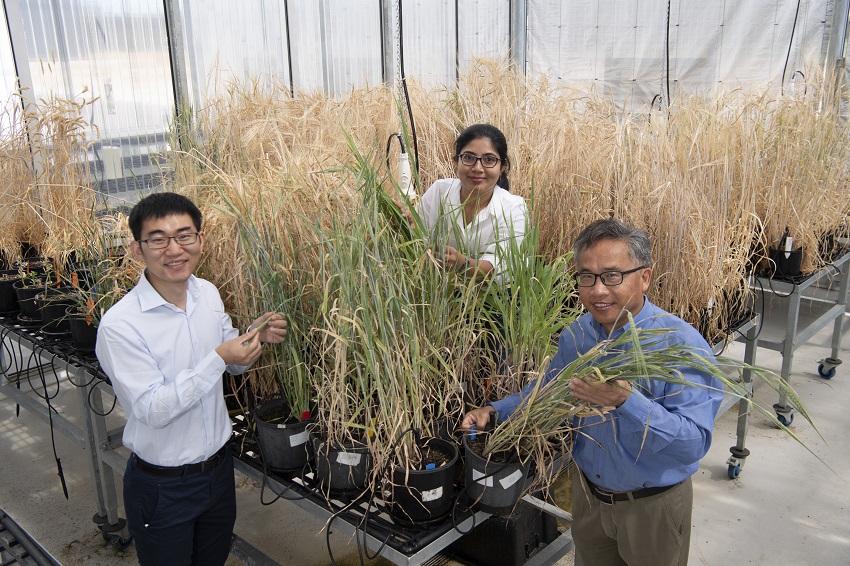
New barley varieties with significantly improved nitrogen efficiency to help reduce fertiliser use and greenhouse gas emissions are on the horizon, as a result of advances made by a Western Australian research collaboration.
The Western Crop Genetics Alliance, between the Department of Primary Industries and Regional Development and Murdoch University, has used gene editing technology to lift nitrogen use efficiency without compromising yield or quality.
The nitrogen content of the new barley lines was up to 50 per cent higher at half the nitrogen rate, when compared with the control varieties in glasshouse trials, while grain yields increased by up to 30 per cent under typical nitrogen fertiliser application rates.
Alliance director Chengdao Li said the CRISPR/Cas 9, or Clustered Regularly Interspaced Short Palindromic Repeats, technology accurately turned barley genes on or off to create the superior trait.
Professor Li likened the use of CRISPR technology to that used by a surgeon during an operation.
“Just as a surgeon uses scissors to remove unwanted material, CRISPR silences or cuts out undesirable genes that regulate nitrogen use,” he said.
“The removal of these genes delays senescence, or haying off, by 10 to 14 days for grain filling, while increasing chlorophyll production by 50 to 180 per cent – providing an additional week or two for grain filling.
“This results in increased grain protein and grain plumpness – particularly desired for malting grade barley – and grain yield, under low nitrogen supply.”
The technique was performed successfully on an old European barley variety, Golden Promise, as well as the popular Australian variety RGT Planet.
Professor Li said the revolutionary technique would pave the way to reduced dependence on nitrogen fertiliser, cutting growers’ input costs and increasing profitability, while supporting efforts for the grains industry to become carbon neutral.
“Nitrogen fertiliser is a key profit driver in grains production, which has seen total nitrogen fertiliser use in Australia increase three-fold in the past 30 years to close to 1.3 million tonnes per annum, worth more than $1 billion,” he said.
“According to the Global Carbon Project, more than half of human-caused nitrous oxide emissions come from agriculture, of which up to 80 per cent is derived from nitrogen fertilisers.
“Fertiliser prices have increased radically in recent years, with synthetic nitrogen products currently worth about $1400 per tonne, placing pressure on growers’ profit margins.
“Improving nitrogen use efficiency will not only cut growers’ fertiliser costs, it will also help to reduce water pollution and – most importantly – greenhouse gas emissions.”
Glasshouse trials will be undertaken in 2022 to bulk up seed and the Alliance is looking to work with potential breeding companies to undertake field trials in 2023.
The application of the CRISPR/Cas 9 technology in this case is excluded from the criteria for genetically modified organisms under the Gene Technology Regulations 2001.
The use of the CRISPR/Case 9 technique in barley is the first successful example of an application to a major crop in Australia and has the potential to be applied to other grains and horticulture plants.
Murdoch University Pro Vice Chancellor, Food Futures Institute, Peter Davies, applauded the Alliance for its important contribution to both crop and environmental science.
“This significant genetic breakthrough will generate far reaching benefits – boosting grains production, mitigating global warming and supporting market access,” Professor Davies said.
“Global markets are becoming increasingly discerning about how products are produced so we must find more efficient ways of producing food with lower nitrogen inputs and emissions per unit of product.
“Crop genetics is a powerful tool to satisfy customer demand for sustainably produced food, without changing farming systems or increasing costs, enabling farmers to be internationally competitive, while safeguarding the future of our planet.”
Image caption: DPIRD research scientist Dr Yong Han (left), Murdoch University PhD student Sakura Karunarathne and Western Crop Genetics Alliance director Professor Chengdao Li have developed new barley lines with improved nitrogen efficiency.
Media contacts:
Megan Broad/Katrina Bowers, media liaison +61 (0)8 9368 3937


